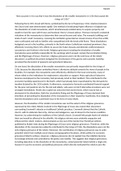Natalie
‘How accurate is it to say that it was the dissolution of the smaller monasteries in 1536 that caused the
risings of 1536?’
Following Henry VIII’s break with Rome, symbolised by the Act of Supremacy 1534, relations between
the Church and state deteriorated rapidly. One method of eradicating Papist influence in England was
the dissolution of small monasteries, which simultaneously enabled Henry to acquire property and
wealth to fund his wars with France and Scotland. Henry’s closest advisor, Thomas Cromwell, conducted
visitations of the monasteries to determine their annual income and value. The monastic buildings and
lands of each ‘small’ monastery, meaning the institution generated an annual income of less than £200,
were confiscated and sold to families who sympathised with the break with Rome. These dissolutions
instigated unrest in the localities, primarily in the North where Catholicism remained prominent, thus
effectively reversing Henry VII’s efforts to secure the Tudor dynasty and diminish conflicts between
Lancastrians and Yorkists in the North. Religious grievances including the dissolution of smaller
monasteries were partially responsible for the uprisings which ensued, namely the Lincolnshire Rising
and the Pilgrimage of Grace. However, religious grievances were not the sole focus of the rebels’
discontent, as political discontent instigated the involvement of the gentry and economic hardship
provoked the discontent of peasants and agricultural labourers.
On one hand, the dissolution of the smaller monasteries was primarily responsible for the risings of
1536, because the dissolution symbolised Henry’s dismissive attitude towards the views of people in the
localities. For example, the monasteries were effectively a lifeline for the local community, many of
whom relied on the institutions for employment, education or support. Many agricultural labourers
became unemployed as the monastery had previously acted as their landlord. This contributed to the
economic hardship experienced in the North, which had already been exacerbated by the demands for
taxation dictated by the 1534 subsidy. Furthermore, monasteries formerly coordinated financial support
for the poor and pastoral care for the sick and elderly, who were at risk if alternative provisions were not
arranged immediately. Monks also copied out and preserved ancient texts, which may be lost or
destroyed in the dissolution. Both the Lincolnshire Rising and the Pilgrimage of Grace declared their
intentions of preventing the dissolution of the monasteries in their respective manifestos, thus implying
that the dissolutions were a pertinent issue in the lives of many rebels.
However, the dissolution of the smaller monasteries was not the extent of the religious grievances
expressed by the rebels. Rebels involved in the Pilgrimage of Grace also stated their discontent
surrounding Cromwell’s attacks on traditional Catholic practices. Cromwell claimed that the Catholic
church, with its elaborate hierarchy, shrines and indulgences, was irrelevant to the human condition.
However, by undermining the traditions of the Catholic church, Cromwell left people fearful of whether
their soul would be affected in the afterlife. His religious reforms were evidently unpopular and
influenced the rebels’ motives, demonstrated as nine out of the twenty-four Pontefract Articles
published by Robert Aske during the Pilgrimage of Grace were religious grievances. Therefore, while the
dissolution of the monasteries evidently contributed to the risings of 1536, the dissolutions were not the
only religious grievance of the rebels. Moreover, the contribution of religious grievances was to unite
potential rebels from multiple social classes and geographical locations, which political or economic
grievances failed to achieve. However, religious grievances do not explain how the rebellion became
increasingly directed and controlled by the gentry and nobility. This suggests that religious grievances,
including objections to the dissolution of the monasteries, united potential rebels behind a single aim,
however it was the economic and political grievances which directly motivated the rebels to join the





